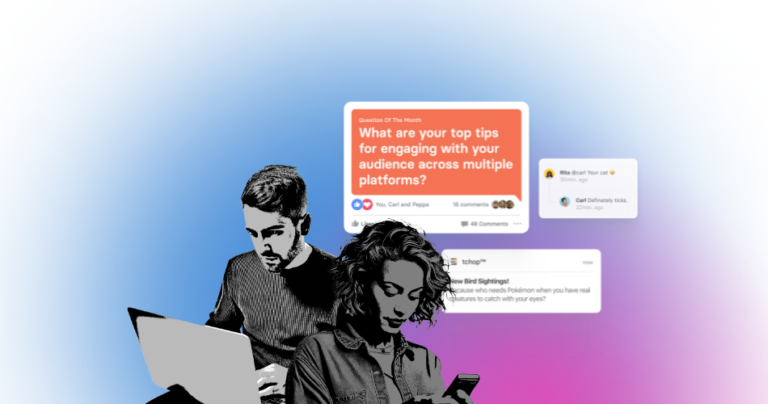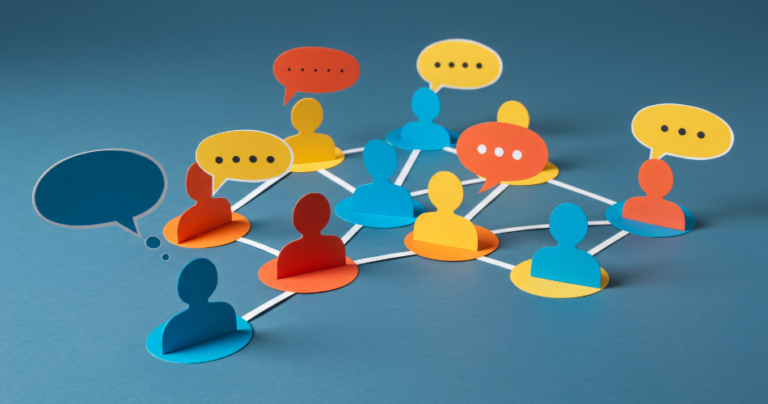Most engagement dashboards start counting too late.
They measure what happens after someone opens your app or clicks a headline. But the strongest sign of loyalty? It happens earlier. Before the click, before the scroll, in that quiet moment when someone expects something to be there.
You know that feeling when you open your phone at 7 AM because The Economist Espresso is waiting for you? Or when you refresh Wordle right at midnight because you can’t help yourself. There’s this brief pause before The Guardian’s live blog updates again. That little “what’s next?” moment. It doesn’t show up in any metric, but it’s real.
That’s anticipation. And it matters more than we realize.
No dashboard tracks it. But every loyal reader experiences it. This goes beyond time spent on page or visit frequency. It’s about emotional readiness. You wait because you trust what comes next will be worth your time.
Publishers chase attention constantly. The thing is, attention doesn’t last. Anticipation accumulates. Over weeks and months, it changes how people relate to your publication. Consumption becomes connection. Connection becomes loyalty.
So the challenge isn’t just keeping audiences engaged. It’s getting them to look forward to coming back. When you design for expectation rather than just reaction, you’re playing a different game entirely.
Why anticipation feels different from habit
Habits are mechanical. They run on autopilot. Same route to work, same coffee order, same scroll through morning headlines. You don’t think about it. You just do it.
Anticipation works differently. It’s active. Emotional. When someone waits for your daily edition, they’re showing you trust. They believe what comes next will be worth their time.
There’s something interesting happening in your brain during that waiting period. Dopamine gets released not when you receive a reward, but when you expect one. So the pleasure isn’t in reading the news update. It’s in the moment before. That readiness you feel when you know The Athletic’s daily newsletter is about to drop. The way you instinctively open Reddit right when your favourite subreddit usually posts. Your brain lighting up with expectation.
This is where things shift for publishers.
Engagement shows interest. Loyalty shows preference. But anticipation? That shows belief. It’s checking the app before the push notification arrives. It’s opening the site because you know something good will be there, not because an alert told you to.
Engagement keeps people present. Anticipation keeps them coming back.
So what creates that feeling? And how do the best media products sustain it day after day?
What every newsroom can learn from how the brain waits
Anticipation isn’t magic. It’s a loop your brain builds through repetition, emotion and reward. Every time you wait for something and it delivers, that circuit gets stronger.
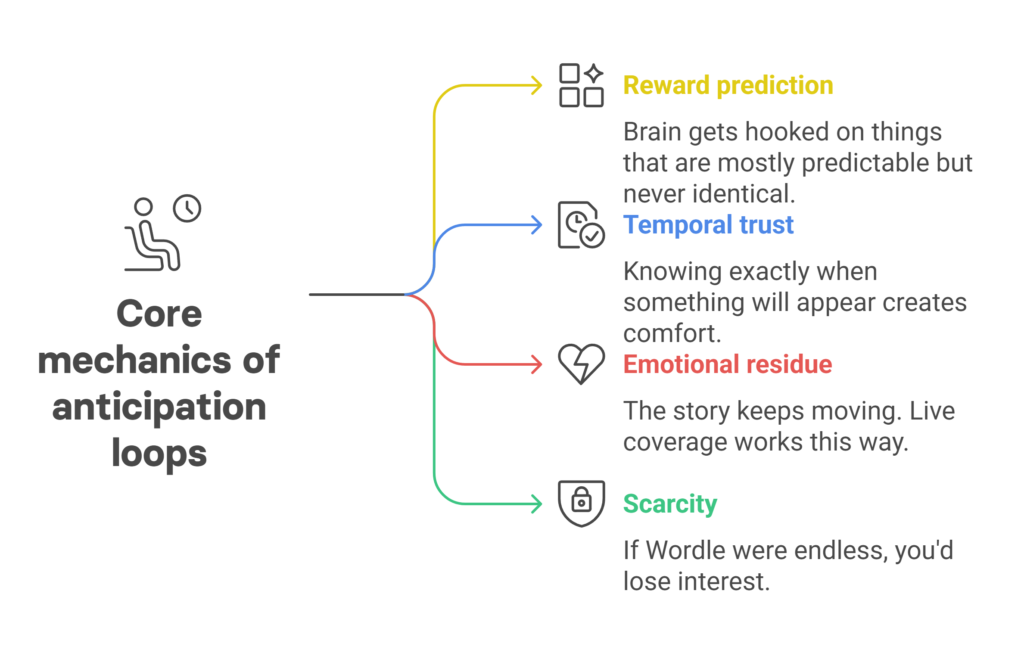
Reward prediction
Your brain gets hooked on things that are mostly predictable but never identical. The sweet spot is that tension between knowing and not knowing.
Wordle nails this. You know there’ll be one puzzle every day. But you have no idea what it will be. That uncertainty keeps you coming back, reliable enough to trust but surprising enough to stay fun. Complete randomness feels chaotic. Total predictability gets boring. Wordle sits right in the middle.
Temporal trust
Knowing exactly when something will appear creates comfort. The Economist Espresso lands in your inbox at the same time every morning. After a while, the consistency itself becomes valuable. You’re not just opening it for the news. You’re checking that the rhythm of your day still holds.
That repetition builds trust. In a chaotic information environment, something that always shows up when it promises to becomes an anchor.
Emotional residue
Sometimes what pulls us back is the fact that the story keeps moving. Live coverage works this way. The Guardian’s live blog doesn’t wrap things up neatly. It gives you progress, update by update, quote by quote.
That sense of incompleteness leaves something behind. A trace that lingers until you check again. You’re following for emotional resolution as much as information.
Scarcity
If Wordle were endless, you’d lose interest. That single daily puzzle turns restraint into ritual. You can’t binge it, so you anticipate it.
Scarcity signals value in media too. Limited newsletter editions. Weekly drops. Seasonal series. The boundaries make it feel special and the wait becomes part of what makes it good.
The loop that keeps looping
These mechanics form a cycle: expectation, reward, memory, expectation. Each time through makes the next one stronger.
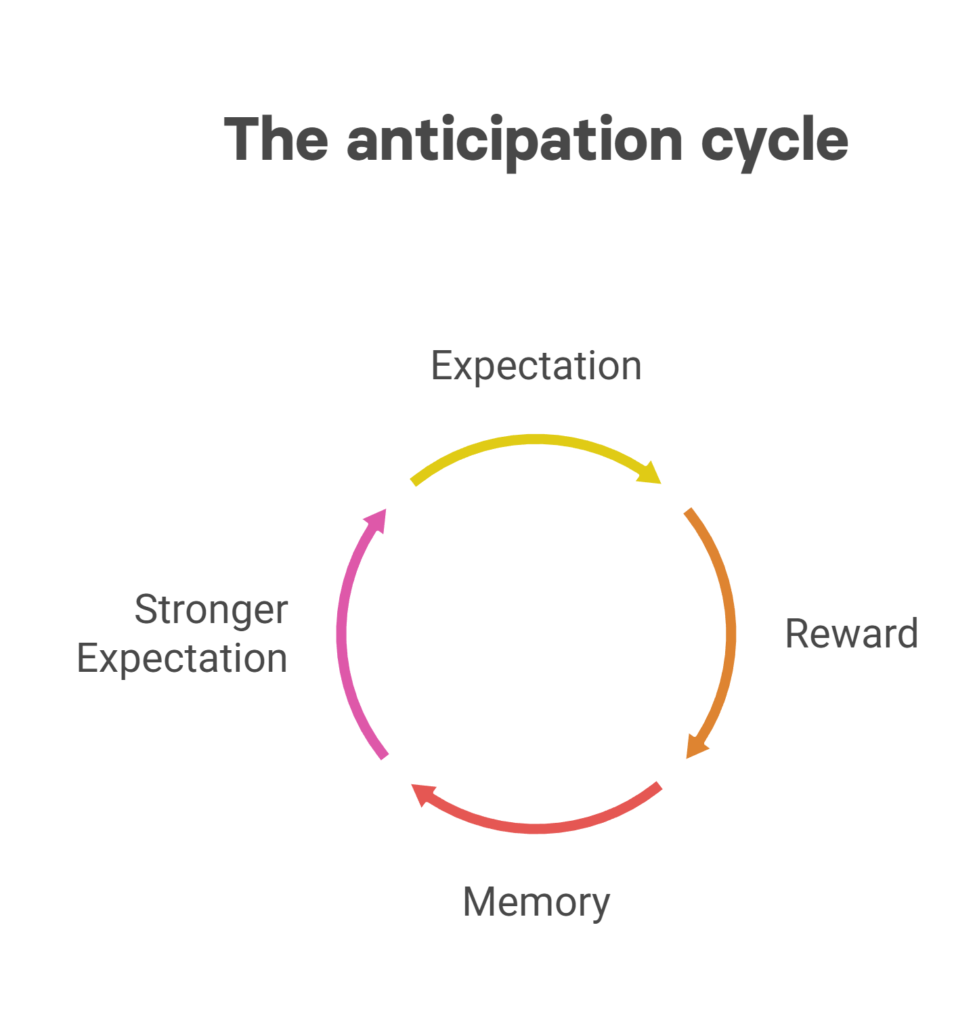
You remember how satisfying yesterday’s Wordle felt. The calm of your morning Espresso. The pulse of following that live blog. Your brain starts looking forward to it again before you even realize it. Waiting turns into wanting. Wanting builds loyalty.
You can design for anticipation. Not by manipulating people, but by creating rhythm. And rhythm is where design begins.
How news products can design for rhythm
Every product has a rhythm. Most newsrooms treat design as a visual problem when it’s really a temporal one. How often and when your product delivers value matters just as much as what it delivers. You’re designing the timing, not just the screen.

Temporal anchors
When readers know exactly when something will appear, they don’t need to search or guess. One less decision in a day full of them.
The Economist Espresso and Axios AM work because they mark the day like your morning coffee does. After a while, you’re not just getting information. You’re getting that reassurance: this thing will always be here when I need it.
Micro-rhythms
Some rhythms happen in seconds. You’ve felt this with live blogs or sports tickers. You refresh, get an update, refresh again. Pace that loop too slow and your attention fades. Too fast and the tension disappears.
The best real-time products use pacing like a heartbeat. Steady enough to trust, dynamic enough to feel alive.
Macro-rhythms
Weekly newsletters work differently. So do investigative series and podcast seasons. Their rhythm stretches time. Each release carries more weight because of the wait between them and that gap isn’t empty. It’s emotional build-up.
The best long-form formats make waiting feel like part of the experience rather than an absence of it.
Visual cues
Loading bars. Countdown timers. “Coming next” labels. You’ve probably never thought twice about them, but they’re telling you something is happening.
Good design doesn’t erase waiting. A progress bar sustains attention. A teaser invites curiosity. The smallest cues turn passive time into engaged time.
Push notifications
Push alerts get treated like megaphones when they’re really ritual re-igniters. They remind you that something familiar is happening again. The best ones nudge anticipation instead of demanding attention. They say: it’s time again.
Anticipation is a rhythm that design can nurture. Timing creates familiarity, variation keeps it alive. Design around time instead of just content and you build something that feels predictable enough to trust and surprising enough to love.
Design sets the rhythm. But it’s storytelling that keeps it playing.
What great editors know about anticipation
Why do you actually come back to a publication? Rarely because of when something posts. It’s what happens when it does. Editorial pacing determines whether someone cares enough to wait. In news, anticipation isn’t just about timing. It’s emotional continuity. Unfinished stories. Investigations that keep evolving. Voices you trust to return with the next piece.

Tone and structure
Every piece of journalism has an emotional arc. How it opens, where it pauses, how it resolves determines whether readers feel done or whether they want more.
The Atlantic and ProPublica do this well. Their investigations unfold like serialized storytelling, each instalment deepening what you know while leaving just enough open to invite you back. You feel guided, never manipulated. The balance between disclosure and restraint matters. Say too much and you end the conversation. Say too little and you break trust. The art is knowing which question to leave hanging.
Open loops
Live blogs still work with this. “More updates coming soon” and people keep refreshing. Long-running series carry a thread forward from one headline to the next.
What these open loops do is signal that the story continues. You’re still part of it. Momentum creates anticipation. Readers get invited to follow along.
Headlines and teases
A headline that works sustains expectation beyond the moment you read it. Newsletters starting with “Previously…” remind you there’s a world unfolding and you’re living in it. Build that connective tissue across time and readers stop feeling like each article stands alone. Each one carries forward to the next.
Tomorrow value
Stories need to carry a subtle promise. Something worth checking back for. Maybe the next update in an investigation. Maybe a follow-up interview. Sometimes just a shift in tone that signals something’s evolving. The best serialized formats understand this: resolution in parts, anticipation spread across the whole. That’s what transforms reading into emotional habit instead of mechanical routine. Readers return because the story is still unfolding and they want to witness it.
Anticipation comes down to trust. Trust that something will keep moving, trust that the people you follow will carry it forward. Storytelling develops that trust through pacing and voice. But where does it actually live? In the spaces between stories, in those quiet moments when readers are waiting.
How to read anticipation in your analytics
Anticipation happens before your analytics even wake up. It lives in that gap between wanting something and actually clicking for it. Someone’s already thinking about your next update. They haven’t opened anything yet. That’s why metrics miss it. They start counting too late.
But it leaves traces if you know where to look.
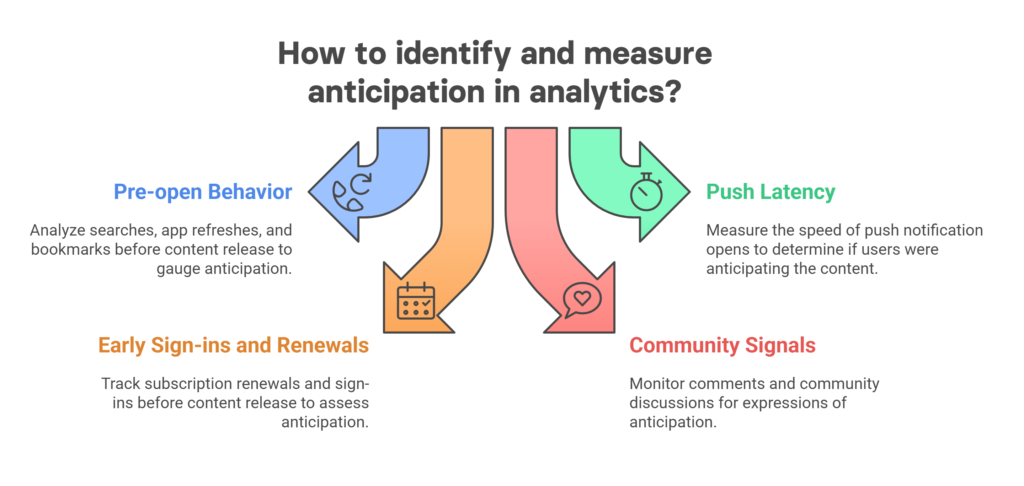
Pre-open behaviour
Before Wordle drops at midnight, searches spike for “Wordle answer” and “Wordle timer.” That’s not engagement yet. That’s people waiting. You can see it happening.
Newsletter subscribers open the app before the episode lands. They refresh early, save bookmarks ahead of time. None of these are huge signals on their own, but together they sketch something real. Your audience shows up for things that haven’t happened yet.
Push latency
When you send a push notification, most teams stare at open rates. But latency reveals something different. How fast people open tells you whether they were already mentally ready or just stumbling across it.
Instant opens within seconds mean anticipation. Slower opens are still engagement, but reactive. Two very different stories.
Early sign-ins and renewals
Readers who renew subscriptions before they expire are signalling something. So are the ones logging in before content drops. They anticipate value enough to act first. It’s subtle but real, an operational measurement of faith in your rhythm.
Chatter and community signals
Numbers show what people do. Conversations reveal how they feel.
You’ll notice it in comments and community spaces. “Can’t wait for tomorrow’s update” or “hoping there’s a new episode today.” These aren’t viral moments. They’re belonging. And they usually appear before engagement spikes. Early warning signs of momentum building.
The clues won’t fit neatly, but together they outline where anticipation actually lives. You’re hunting for timing with intent. When do people return on their own? When do they check in before you ask them to?
Most analytics tools won’t label it “anticipation.” But the behaviour is measurable. And once you recognize it, you start understanding how valuable it truly is. Not just as engagement. As durability. The audiences who wait are the ones who actually stay.
What anticipation means for retention and revenue
If engagement fills the funnel, anticipation protects it. It’s the invisible layer that turns casual audiences into subscribers who stay, renew and forgive the occasional glitch.
You’ve probably experienced this yourself. A slow app load, a temporary paywall issue. When you’re waiting for something you actually care about, friction feels different. Your expectation outweighs the inconvenience. That’s emotional credit.
Watch the most resilient subscription products. Newsletters with reliable cadence. Daily puzzles. Serialized investigations. Their renewal rates stay high even when everything else wobbles. Users have built temporal trust. They believe in what comes next.
Think of it as temporal equity. Every time you deliver consistently, your audience invests more emotional time. Weeks and months of building something together. It compounds. The harder it becomes to replace you, the longer they stay. That’s your moat.
Most publishers live in fear of the algorithm. One platform change and traffic vanishes. Anticipation-based products don’t have that problem. When readers expect value directly from you, the algorithm stops mattering. They’re not following feeds. They’re following rhythm. That’s why Wordle survived being bought by the Times without losing anything. The loyalty wasn’t to a platform. It was to the waiting.
You don’t need to force conversion when people already feel ownership. A reader anticipating your next story isn’t evaluating whether to pay. They’re maintaining something they already care about. That’s why these products outperform everywhere. Reader revenue. Membership retention. Ad engagement. They’ve already convinced themselves your work is worth supporting.
Anticipation isn’t just another engagement metric. It’s a business asset that resists duplication. You can’t buy it. You can’t copy it. You can’t easily disrupt it. Once readers start waiting for you, they stop looking elsewhere.
That’s the moat. Built on rhythm, not volume.
What the next era of retention looks like
For years, publishers have been chasing the wrong thing. Session length. Time on page. How long someone stays with you in a given moment. Every dashboard obsesses over it.
But that’s not actually loyalty. That’s just attention.
Real loyalty is different. It’s whether someone comes back because they expect something from you. Whether they organize their day around you. Whether you’d be missed.
Think about what you care about. You don’t measure it in minutes spent. You anticipate it. You check before you’re prompted. You’d notice immediately if it disappeared.
Most publishers haven’t built toward that. They optimize for spikes. They chase viral moments. Meanwhile, the products that actually survive don’t chase anything, they just show up consistently. People build their routines around them without even realizing it.
Newsletter subscribers renewing before expiry. Readers logging in ahead of time. These aren’t engaged users measuring their loyalty. They’re people who expect something tomorrow and they’re making sure they don’t miss it.
The second that expectation breaks, they’re gone. By then they’ve already found something else to care about.
What if publishers asked a different question?
Not “How many people opened our app today?” but “What are people looking forward to from us tomorrow?” That answer tells you everything about whether you’ve actually built something durable or just another thing people consume once and forget.
Anticipation is the only loyalty worth having. It’s proof that what you make has become part of how someone lives. And once that happens, they protect it.




